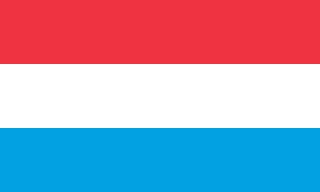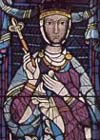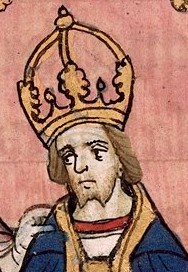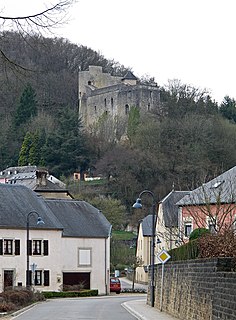
Septfontaines is a small town in western Luxembourg. It is part of the commune of Habscht, in the canton of Capellen.

The architecture of Luxembourg probably extends back to the Treveri, a Celtic tribe who prospered in the 1st century BC. A few ruins remain from the Roman occupation but the most significant contributions over the centuries have been the country's castles and churches. Today there is a veritable architectural boom as Luxembourg's economic prosperity provides a basis for developments in the financial, EU and cultural sectors with a number of world-class buildings.

The Château de Septfontaines is located in the Rollingergrund district of Luxembourg City. Now a listed building, it has been associated over the years with Luxembourg's Villeroy & Boch porcelain factory, which closed in 2010.

Bourglinster Castle is located in the village of Bourglinster in central Luxembourg some 17 km (11 mi) to the east of Luxembourg City. Now housing a restaurant and facilities for business and cultural gatherings, the castle has a history stretching back to the 11th century.
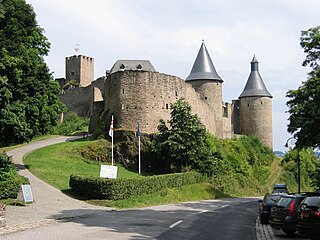
Bourscheid Castle is located near the village of Bourscheid in north-eastern Luxembourg. The medieval castle stands on a site with archeological evidence of structures dating back to Roman times. Standing majestically some 150 metres (490 ft) above the River Sûre, it is enclosed by a circular wall with 11 watchtowers.

Hollenfels Castle, with a history dating back to the 11th century, is one of the castles located close to the River Eisch in the Valley of the Seven Castles in central Luxembourg. Today it is used as a centre for activities for young people, including a nearby youth hostel.
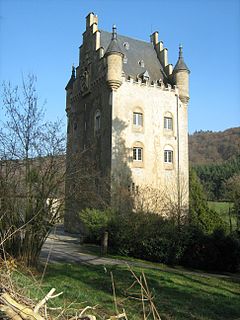
Schoenfels Castle, with a history dating back to the 12th century, is one of the castles belonging to the Valley of the Seven Castles in central Luxembourg. Located in the village of Schoenfels in the Mamer Valley between Kopstal and Mersch, it now belongs to the State of Luxembourg.

Ansembourg Old Castle, known as the Old Castle of Ansembourg, in central Luxembourg is one of the castles belonging to the Valley of the Seven Castles. Located high above the little village of Ansembourg, the medieval castle is the private residence of the current Count and Countess of Ansembourg.

Bettendorf Castle is located in the village of Bettendorf in eastern Luxembourg. While there appears to have been a castle from the 13th century, today's Baroque building dates from 1728 and was restored in 1962. The castle is privately owned and cannot be visited.

Differdange Castle, located on a hill in the centre of Differdange in southern Luxembourg, was built in 1577 although an earlier fortified castle of Differdange dates from around 1310. Today's residential château is used by Miami University.
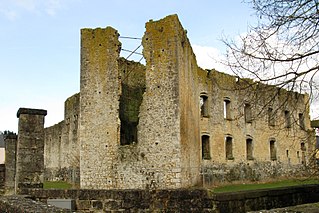
Koerich Castle is a ruin located in the village of Koerich in central Luxembourg. With a history dating back to the 12th century, it is one of the castles in the Valley of the Seven Castles.
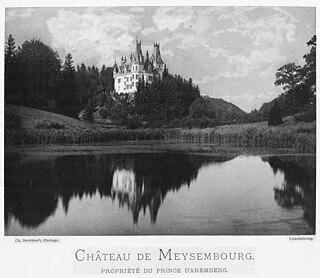
Meysembourg Castle is located some 2 km south-west of Larochette in central Luxembourg. While the site has a history dating back to the 12th century, today's castle was built in 1880 in Neo-Renaissance style and is privately owned.

Esch-sur-Sûre Castle, now a ruin, is located on a spur in the small town of Esch-sur-Sûre in the north-west of Luxembourg. It is naturally protected by a sharp meander in the River Sûre which surrounds the town and the castle on three sides.

Brandenbourg Castle, now a ruin, is located on a promontory some 70 metres above the village of Brandenbourg in north-eastern Luxembourg. It has a history going back to the 9th and 10th centuries when there was a wooden fort on the site. The 13th century keep, now 11.9 metres high, used to have four floors, only three of which remain. In 1668, the French attacked the castle which subsequently fell increasingly into ruin. It is now owned by the Luxembourg State.

Stolzembourg Castle is located on a hill in the centre of the village of Stolzembourg in north-eastern Luxembourg. The current building was built on the ruins of the medieval castle in 1898 in the style of a Scottish country house.

Born Castle is located in the centre of the little village of Born some 8 km north of Wasserbillig in south-eastern Luxembourg. It has a history dating from 1286 when the Lords of Born lived there. In particular, they were associated with the families of Hattstein, Faust d'Aschaffenbourg and de Villers. Today's castle was built on the old site in the 18th century and is privately owned.
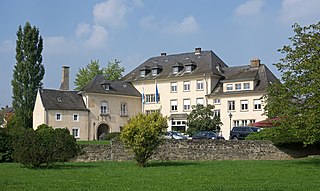
Stadtbredimus Castle, located on the banks of the Moselle in the village of Stadtbredimus in south-eastern Luxembourg, has a history going back to the 13th century when a fortified castle stood on the site. In 1724, today's castle was built on the ruins of the old fort and, after some questionable restoration work, was bought by the la Fontaine family in 1802. It was here that Luxembourg's national poet, Edmond de la Fontaine, better known as Dicks, lived from 1858 to 1881.
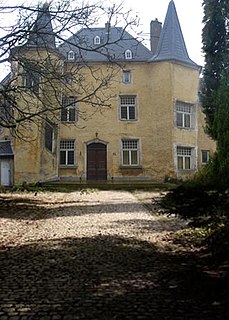
Wintrange Castle, located in the centre of Wintrange near Schengen in south-eastern Luxembourg, is a privately owned Renaissance style castle built in 1610 and can be rented for weddings, events, film, and photo location.

Munsbach Castle is located to the southwest of Munsbach near Schuttrange in central Luxembourg. It now belongs to the Institut Universitaire International Luxembourg which provides educational courses in business, European law and public sector management.

Bettange-sur-Mess Castle is located in the village of Bettange-sur-Mess near Dippach in the southwest of Luxembourg. Built in 1753 by René Louis de Geisen, the castle has changed ownership several times. Since 1996, it has been a retraining centre for mentally handicapped persons run by the Association des Parents d’Enfants Mentalement Handicapés.


